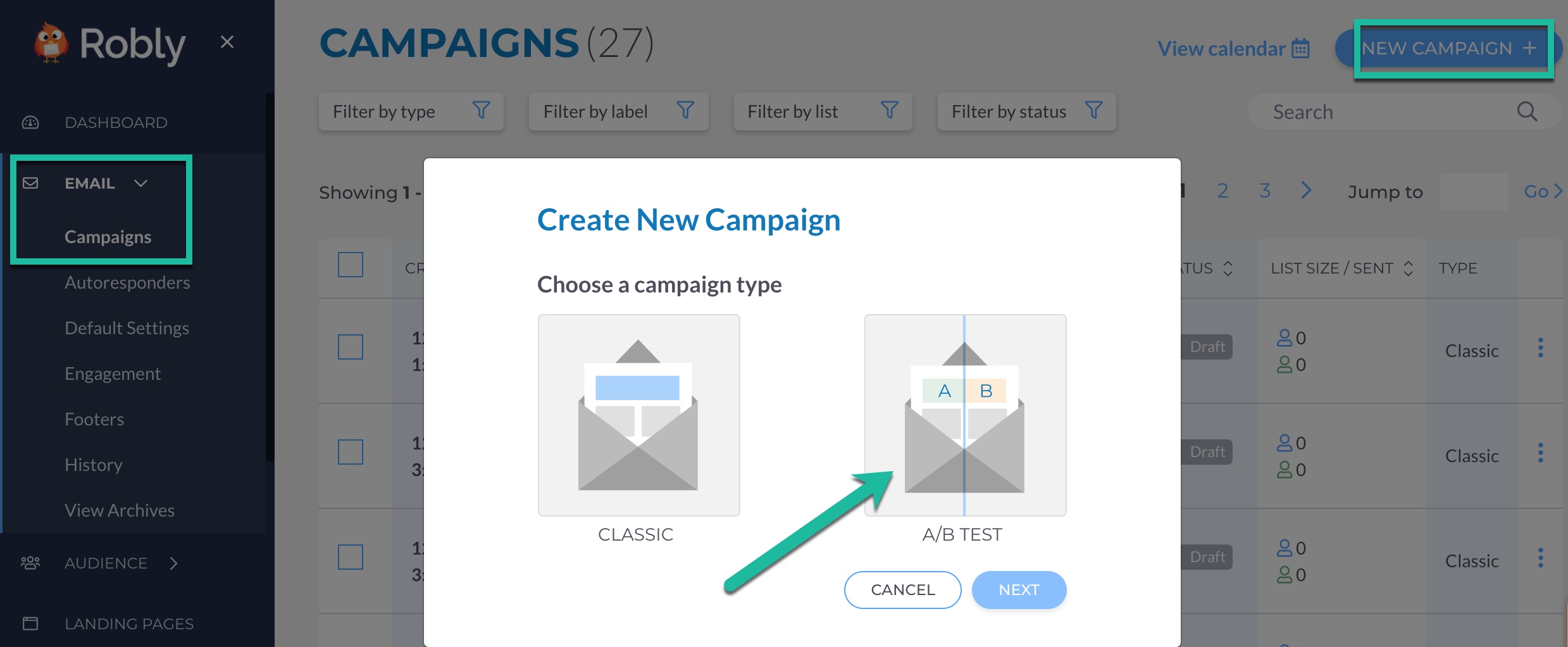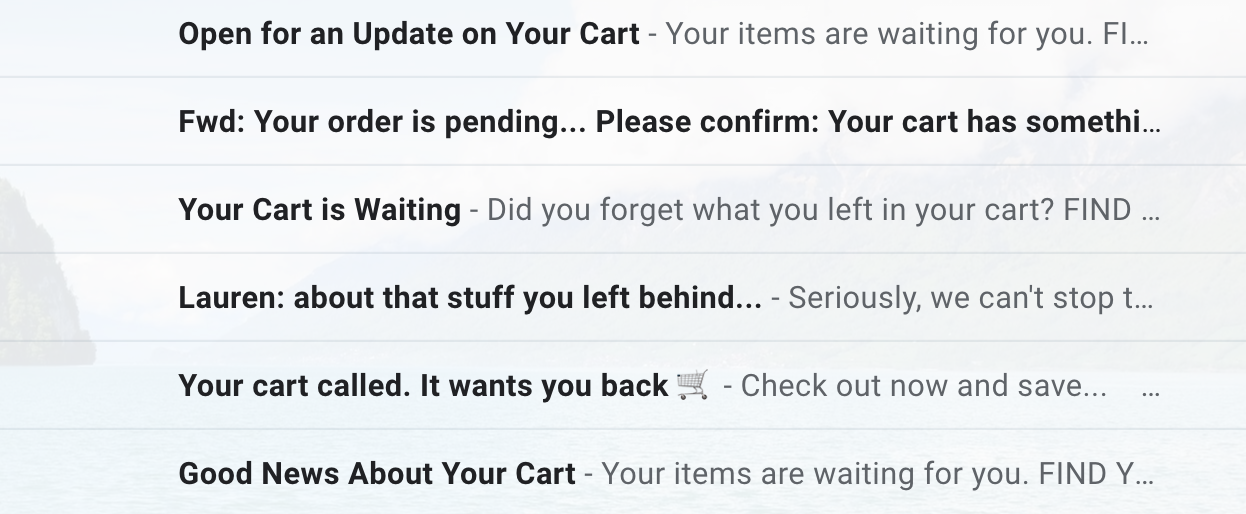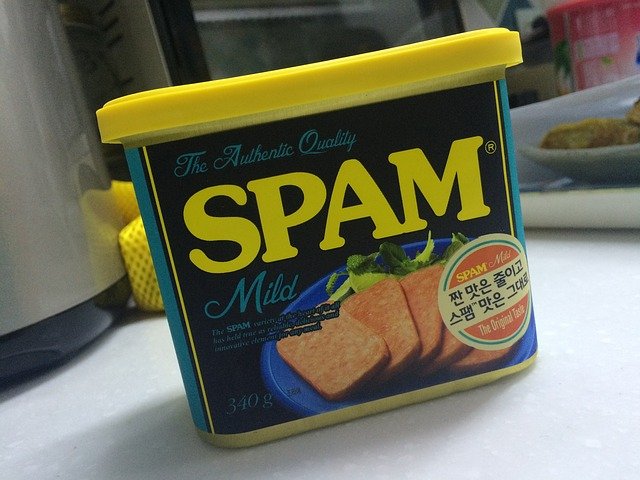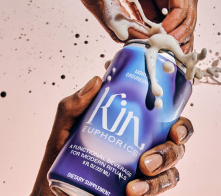An online shopper just viewed one of the products on your website — or several, if you’re lucky — but they left before adding it to their cart and making a purchase. So, how do you not only get them back to the product page, but also push them to purchase the item? Through an email campaign, of course. And how do you ensure they open those amazing campaigns? You create engaging browse abandonment subject lines.
It’s no secret that subject lines are a vital component of any email marketing strategy. If you don’t have a good one, subscribers aren’t going to have a reason to open your message. They are one of the first things they’ll see, you know. And if they aren’t opening your browse abandonment emails, you can forget sending them back to your site with the CTA inside of your message.

Ready to learn how to craft catchy subject lines that will consistently earn you opens for your browse abandonment emails? We’ve got you covered. Here’s a glimpse into what we will cover in this intensive guide:
- What’s browse abandonment — and why you should be focusing on it
- 11 components of engaging subject lines
- Why A/B test browse abandonment subject lines
- 97 examples of browse abandonment subject lines
- What to do if you aren’t getting opens
- How to collect anonymous browse abandonment traffic
What is browse abandonment (and why should you care)?

Anytime an online shopper views one or more products on your e-commerce site and leaves, they’ve performed browse abandonment. Unlike cart abandonment, these shoppers never actually added a product to their carts — they simply left after viewing it.
Browse abandonment is a serious issue for e-commerce stores, considering 97 percent of first-time users leave an online store without making a purchase. Of those, 85 percent never add a product to their cart. Ouch. Though, I’m sure we’re not telling you anything you don’t know.
But, something you might not be as aware of is the silver lining to browse abandonment. Did you know 42 percent of revenue is generated from browse abandonment campaigns? So, if you engage them after they’ve viewed and left your site, you can experience some serious ROI.
To best do that, you’ll need to create winning browse abandonment subject lines. And yes, some of the subject lines you create might be similar to what you’d use for abandoned cart emails — they do both involve abandonment.

But, you would want to make sure you didn’t use words like “cart” or “abandonment” in these subject lines. Browse abandoners have only viewed and left your site, so you wouldn’t say things like you “reserved items” for them or “your cart is about to expire.”
You can also be less specific with browse abandonment emails, compared to their cart counterpart, because they aren’t as far down the sales funnel. That gives you more of a chance to have fun with the subject lines, blending a bit of promotional, discount, and branding together to bring them back. Since these shoppers do have lower interest than cart abandoners, you can emphasize other factors like the return policy or free shipping, as well.
Components of engaging subject lines

When you’re writing browse abandonment subject lines or ones for any other type of email campaign, there are a few general rules to give you the best results (i.e. opens). Here are 11 of the best ways to catch your subscribers’ attention with subject lines and make them want to read your email:
- Add personalization (ex. their first name, the product name/category they viewed)
- Create a sense of urgency
- Keep the text short and sweet (ideally 40 characters or less)
- Tell them what’s inside of the email
- Be concise
- Don’t make false promises (your email better deliver whatever the subject line says)
- Avoid using multiple exclamation points
- Don’t put the text in all caps: IT LOOKS LIKE SPAM
- Make them feel special
- Use numbers (characters are limited already, and numbers stand out more)
- Use your brand’s voice
One of the other things your subscribers will see first is the “from” field. So, make sure to email them from a consistent person’s name, email address, or brand name so they automatically recognize who the message is from. We’ll dive into that topic a little more at the end, as well.
https://www.youtube.com/watch?v=5py5PLLB-3o&t=1s
Why to A/B test subject lines

If you send an email marketing campaign and it has poor results, you might wonder if it was the subject line, time of day you sent it, or another factor that contributed to its demise. But if you perform an A/B test, you can put each component under a microscope to figure out what did and didn’t work. That’s why testing your browse abandonment subject lines is so important.
Try testing out these different factors with your subject line to see what your audience prefers:
- Different lengths
- Personalization (names, product/category names, other data you have about them)
- Emojis
- Approaches (ex. discounts, urgency, puns, etc.)

You can also try out different versions and approaches when it comes to your preview text. How you create an A/B test campaign will depend on the ESP you use, but here’s what the option looks like in Robly:

Remember: You should only test one element at a time. If you try out different subject lines, body text, and designs all in the same test, you’ll never know which one worked the best. You always need to have a control version during the test, just like you would any other experiment.
Examples of browse abandonment subject lines

We’ve put together 97 subject line examples for browse abandonment emails. Test them out with your audience, tweak them to better target your subscribers, try capitalizing the first letter of each word (and vice versa), or simply use them as a way to get the creative juices flowing.
Popular (and simple) options

There’s a reason you see so many brands use similar approaches when it comes to browse abandonment subject lines. That’s because they work. They are straight to the point and short enough to be seen in full, even on mobile devices — giving you a winning combination.
You’ll notice several of these are similar, with only a word or two different. So, use what sounds most natural to your brand’s voice.
- Thanks for stopping by
- Take a second look!
- See something you liked?
- Did you see something you liked?
- Take a 2nd look
- Still thinking about it?
- Still thinking it over?
- What did that look like again?
- Where’d you go?
- Was it something we said?
- What happened?
- Take another peek
- Oh hello again…
- Did you want it?
- Still deciding? No problem!
- Take another look and make it yours
- Still interested?
- Go on. Give it a try!
- Take another look
- Have your eye on something?
- A gift for you
- Oops, you forgot something
Personalized subject lines

Crafting the browse abandonment subject line so that it looks like it was written just for the shopper will catch their attention and make them feel more connected to your brand. We all want to be seen as an individual, instead of a faceless number on an email list.
It’s especially important to send yourself a test email to ensure the personalization is showing up correctly. Having a subject line that ends up looking like this in their inbox will do way more damage than not having their name in the subject line at all: “Hi NAME, check this out!” You want to ensure you’re using the correct format to pull their names into the line.
Also, if you don’t have their name in your system, make sure your ESP plugs something else in, like, “Hi there!” or simply, “Hi!”
One note

If your company doesn’t have physical products, like a travel company or service, to mention, you can instead input information about what places they are interested in visiting or the type of service they viewed. Not only are you personalizing the emails for the online shopper, but you’re also personalizing it to your business.
To achieve that level of personalization, it’s important to put in the back-end work so that it’s actually possible. That means properly categorizing your products or services so your automated emails can pull in the correct information. Just like you wouldn’t want their name to show up incorrectly, you wouldn’t want to email them information on a mattress if they originally viewed pet supplies. Unless they are interested in dog beds, we suppose.
A second note

While these are specific examples of personalized browse abandonment subject lines below, you can personalize any email of the other examples in this guide by simply adding their name to them. And for the sake of the examples, we’re going to plug in “John” for the consumer’s name and “chair” and/or “lawn chair” for the browsed product.
- John — you have great taste!
- John, did you see something you liked?
- Hey John, any questions?
- Your chair is waiting
- That lawn chair is still waiting for you!
- Recommended just for you
- You know you want this
- Hey, you left without your chair…
- Where’d you go?
- We want you back
- What did that chair look like again?
- Surprise, John! Come back and get 20% off
- Remember your chair? It’s about to sell out
- Say goodbye to your chair
- John, don’t let this chair get away from you
- You’ve come so far, John, don’t give up!
- We hate to see you go…
- Picked only for you
- Is this your next chair?
- John, continue shopping with a discount!
As you’ll notice, you don’t always have to put their name or the product name to personalize the subject line. Using “you” will also make it feel personalized, so try that approach, as well.
Create a sense of urgency

No one wants to miss out. So, use that mindset in your campaign’s favor, showing browse abandonment shoppers they need to head back to your site ASAP. If they don’t go back, well, that’s too horrible to even think about.
While we don’t love using exclamation points too often, they can be especially powerful when it comes to creating a sense of urgency with your browse abandonment subject lines.
- That item might not be there much longer
- Come back before it’s too late!
- Act fast to get 15% off!
- Don’t let your favorite item sell out!
- Ending in 10, 9, 8…
- Blink, and you’ll miss it
- Don’t regret missing out on this!
- This item is almost sold out!
- Don’t miss out on [product]!
Recommended products

The online shopper viewed the product, sure, but they didn’t actually add it to their cart. So, it’s hard to say how interested they are in the specific product they looked at. Give them a chance to see other related products, in case one of them will better catch their eye.
- We picked these items just for you
- This week’s Top 10 sellers
- These Top 15 products are going fast…
- View our [product category] selection
- Our [product category] are selling fast
- Our latest products in [product category]
Address concerns

Maybe there was a reason they left your site before adding the product to their cart and completing the purchase. Perhaps they were trying to find another item but had no luck. Or, they had a question before they committed to the product. Whatever the reason, use your subject line to show them you get it and can help.
- Searching for [product category]?
- Couldn’t find what you were looking for?
- Shopping for [product category]?
- Thanks for visiting. Need help?
- We didn’t get a chance to say hello…
- Would you like to keep hearing from us?
- Can we help you with your order?
Focus on discounts

Everyone loves a good deal. That’s no secret. But what might not be as clear is how to properly use the discount technique to get shoppers back to your site. That’s why we’ve put together these examples to give you some ideas.
- Shop now. Save big.
- Big savings ahead
- Open for big savings
- Deals that make us proud
- We want you back — take 10% off
- Here’s how we’re going to look after you
- Maybe this will help — $10 off, just for you
- That chair is now 15% off!
- A gift for you
- Let’s sweeten the deal
- Don’t let free shipping go to waste
- Only 2 more days for free shipping
- Would a $20 offer change your mind?
While giving the shopper a discount is a great way to get them back on your site, consumers have started to become more immune to this practice — especially with brands that constantly email them about different discounts. So, like with any of the other subject line tactics we’ve mentioned, use it sparingly and mix it up with other techniques. Variety is your friend.
Use emojis

You probably wouldn’t want to use emojis in every subject line you send, but it can be a fun way to catch their eyes and stand out in their inbox. Plus, it shows your readers your brand knows how to have fun and doesn’t take things too seriously. You’re only limited to your own creativity and emoji keyboard with these.
- We saw you peeping…

- Your lawn chair is ready for its close-up

 YAY! The chair you like is on sale!
YAY! The chair you like is on sale!- Wow! You’ve got great taste

- 15% off that item you’re eyeing won’t last!

- Final hours to snag that lawn chair!

- Do a double take

- Continue shopping with a discount

One thing to keep in mind when you use emojis: Make sure you understand the meaning behind the emoji. What might look like one thing to you could actually mean something completely different, so look it up before you use it. You don’t want to have any  moments.
moments.
Get creative

Use your brand’s voice — along with your creativity — to craft browse abandonment subject lines that they’ll remember and genuinely enjoy. Don’t be afraid of using a pun or two, especially if it relates to your brand.
- We must have the same taste
- We saw you checking us out
- Thanks for checking us out
- Were you checking me out?
- Did you have your eyes on these?
- I’m in love, I’m in love!
- Don’t open this email.
- Sorry to hear about your Wi-Fi
- Hello, is it me you’re looking for?
- All is not lost
- Welcome to the wild side (brand is Wet n Wild)
- Is this your next pair? (eyeglass company)
What happens if you aren’t getting opens?

There are several different factors that can cause you to have issues with your open rate. And while you might think you have the most amazing browse abandonment subject lines, you might still be struggling. So, try these different marketing tactics to improve your open rates, and ultimately, your conversion rates.
Segment your browse abandoners

Just like you segment your email lists, make sure to segment your messages based on the data you have on these online shoppers — because the returning shopper isn’t the same as a first-time viewer.
You can create different messages based on the product category, product values, and past purchase history. For example, if you’re trying to get rid of holiday inventory and they view one of your holiday items, offer them a special coupon that’s not included in your other browse abandonment messages.
Or, if the item they viewed has a higher price tag, you could let them know about free delivery, a discount code, etc. The subject line isn’t the only factor that should be customized — the entire focus of the email should as well.
Don't email too much

Another important component of segmenting your browse abandoners is making sure you’re not emailing them too often. For example, if you emailed the user a week ago about a product they viewed, you wouldn’t want to email them again for something else they viewed. You can set your messages to suppress users until after a certain amount of time, like after a month or if they view a different product category altogether.
You want your messages to be valuable and targeted, but not pushy, bothersome, and overwhelming. Don’t make them dread seeing your messages pop up.

Send again
If at first you don’t succeed, try, try again — with a different subject line. For example, if a shopper doesn’t open your browse abandonment email the first day you sent it, send that same email again with a different subject line. And this time, make sure that subject line creates a stronger sense of urgency than the original one.
Send ASAP
Speaking of sending your browse abandonment emails, make sure you’re sending them right away — like within an hour of them viewing your product. They only viewed your product, so it can be easy for them to forget about it if they aren’t reminded by your amazing subject line right away.
Create an email series
One email often isn’t enough to get shoppers who committed browse abandonment back to your site. It may take two or three before they feel the urge to click through and check out your products again.
You can space out these emails to go out every day or two. After about three emails, if they aren’t engaging, you can stop sending the messages — because at that point, they will probably get annoyed if you do. Here’s an example of an email series for browse abandonment emails:
- First Email: Send 20 minutes after browse abandonment
- Second Email: Send one day after abandonment
- Third Email: Send two days (three at most) after abandonment
Each of the emails in the series should use a different approach to win them back, and that includes the approach you take with the browse abandonment subject line. Here’s an example:
- First Email: Supportive and helpful
- Second Email: Gentle but more persuasive
- Third Email: More familiar tone or more urgent
Use a different “from” name

Since the “from” field is one of the first things your subscribers see in addition to the subject line, sometimes it’s the culprit for why they aren’t opening your message. So, if your “from” name is the name of the brand, try changing it to the name of a known brand ambassador, founder, CEO, or other person known to be associated with the brand. Again, this is an example of why A/B testing is important.
Avoid spam filter

It’s one thing to not catch your subscribers’ attention with your subject line. It’s another thing entirely to catch their attention for the wrong reasons. If there are certain words (ex. free, exclusive, act now, etc.), or it’s in all caps with several exclamation points, the subject line is going to scream, “SPAM!” That’s going to lead your subscribers to mark it as such (if the filter hasn’t already), sending your campaign to their spam folder.
Your ESP should mark any subject lines that look like they might trigger a spam folder, and you can also look up lists of words and phrases to avoid. Basically, you want your subject lines to sound natural (something you’d say to a friend) and not include sales-y lingo.
Make a good first impression
Whether you’re sending a browse abandonment email or another type of email marketing campaign, your subject line is your first (and often only) time to catch their attention. First impressions really are everything when it comes to your email marketing efforts, so make sure you make the most of your browse abandonment subject lines in the limited space you’re given.
Just don’t forget: An amazing subject line may earn you the open, but if your content isn’t worth reading or clicking through to see more, it doesn’t matter. So, make sure you’re sending them valuable content, as well.
https://www.youtube.com/watch?v=W_tPhVVRNkU&t=1s
Want some help?
If you want to start identifying your site’s anonymous traffic to engage an even larger audience who browsed and left (while building your email list), give Retention.com a try. We can identify up to 30 percent of your site’s anonymous traffic, giving you their name and contact information so you can follow up with a browsed abandonment email.
Even if you aren’t able to win back the browse abandoners with an email, you can try other approaches with email-based retargeting based off of the other data you collect on them.
You can sign up for a 7-day free trial with up to 25 free contacts with Retention.com, so why not give it a try?





















 YAY! The chair you like is on sale!
YAY! The chair you like is on sale!



 moments.
moments.





